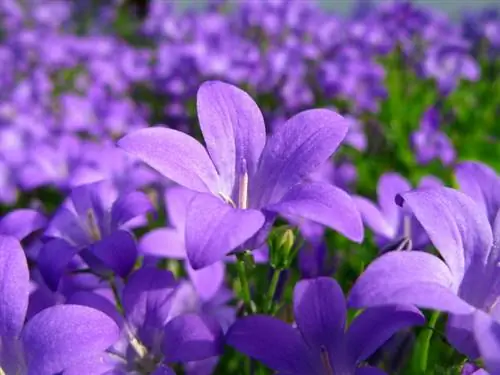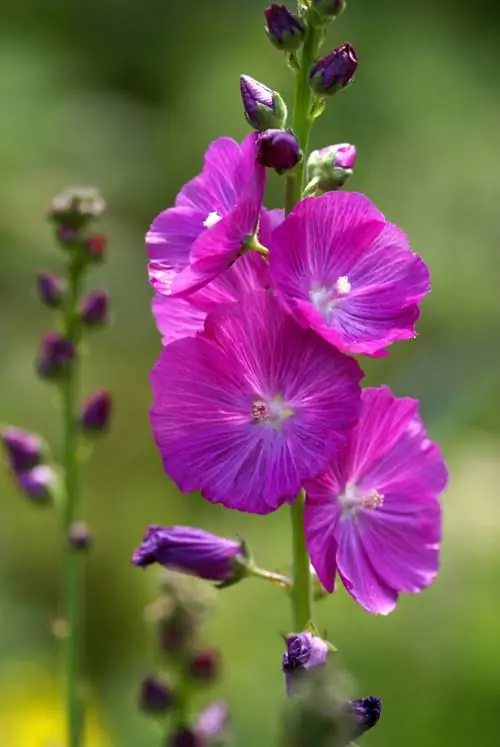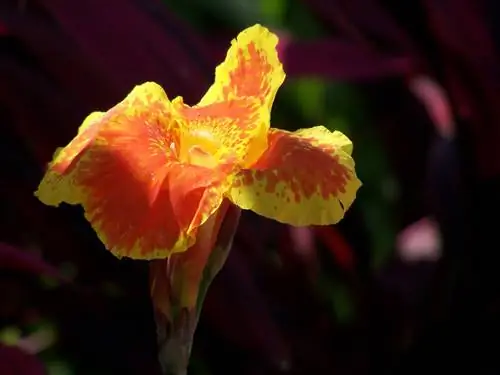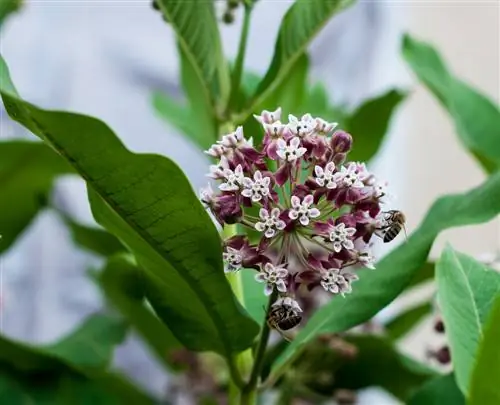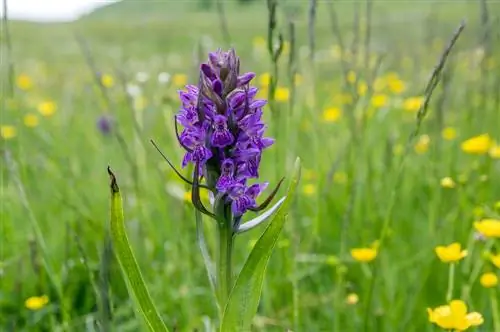- Author admin [email protected].
- Public 2023-12-25 17:45.
- Last modified 2025-01-23 11:22.
As a prime example of flower-rich habitats, the bellflower does not let its gardener down. The cosmopolitan among perennials decorates the bed, the rock garden, the balcony and the windowsill all summer long. If you still have questions about cultivation, discover the answers here.

How to care for a bluebell?
The bellflower, also known as campanula, is a versatile perennial that blooms all summer long. It prefers partially shaded locations, well-drained, nutrient-rich soil and regular watering without waterlogging. Regularly removing wilted flowers and fertilizing promotes flower splendor.
Care tips
In order to enjoy the delicate flower carpet all summer long, no extensive care is required. If you pay attention to the following measures, Campanula will bloom in the bed and pot for what feels like an eternity:
- Keep the bellflower constantly moist without causing waterlogging
- During the flowering period, fertilize organically every 2-3 weeks with compost, horn shavings (€32.00 on Amazon) or nettle broth
- Clean out wilted flowers to encourage attractive re-blooming
- Pruning close to the ground is done in autumn or better in spring before the fresh shoots
In exposed locations, despite its winter hardiness, the perennial receives protection in the form of leaves, straw or needles. Bellflowers in pots or flower boxes move to frost-free, cool and low-light winter quarters before the first frost. During dormant growth, only water Campanula enough to prevent the root ball from drying out. Fertilizer is not administered in this phase.read more
Which location is suitable?
The bellflower feels best in a semi-shady location, protected as possible from the blazing midday sun. This premise applies universally to the broad family of perennials. If you coordinate the position down to the last detail with your favorite species and variety, the flower will achieve its optimum. The dwarf bluebell, which is suitable for the rock garden, does its best in a full sun to sunny spot, while the forest bluebell prefers to stay in a cool, shady place.read more
The correct planting distance
The perfect planting distance should correspond to the chosen type of bellflower. The following overview shows recommended distances in the bed for some of the most popular Campanula. Place the perennial in the balcony box, reduce the specified values by approx. 5-6 cm.
- Carpet bellflower: planting distance 20 cm (16-18 pieces per square meter)
- Carpathian bellflower: planting distance 25 cm (16 pieces per square meter)
- Ball bellflower: planting distance 35 cm (8 pieces per square meter)
- Large-flowered bellflower: planting distance 40 cm (6-8 pieces per square meter)
- High umbel bellflower: planting distance 70-90 cm (3-6 pieces per square meter)
What soil does the plant need?
The demands on lighting and temperature conditions may differ; Campanula largely agree on the nature of the soil. This is how the ideal earth should be structured:
- Deeply relaxed and humorous
- Nutrient-rich and fresh-moist to moderately dry
- Neutral to calcareous
Cultivated in the balcony box, hanging basket or pot, the bellflower likes to spread its roots in loose compost-based potting soil, enriched with a little sand, expanded clay or lava granules.
What is the best time to plant?
The wonderful month of May is the best time to plant a bellflower in a perennial bed, rock garden or on the edge of the tree. From the middle of the month, the danger of delayed ground frosts is over, so that the young plants you have grown yourself or purchased ready-made can grow unhindered.
When is flowering time?
The main flowering period for bluebells is from June to August. With a little gardening attention, you can extend the flowering period by several weeks into autumn. You can achieve this feat by regularly cleaning out wilted flowers or cutting the perennial in half after the first flowering phase.read more
Cut the bellflower correctly
If you cut off withered flowers regularly, the bellflower will respond with a vital re-bloom. You can cut off the withered leaves to just above the ground either in autumn or early spring. If the bellflower acts as a ground cover, pruning can be done in early spring using a lawnmower set to the maximum cutting height.
Attractive campanulas, such as the St. Mary's bellflower, are also suitable for long-lasting cut flowers. Ideally, you should cut the stems in the early morning hours after the perennial has been watered.read more
Watering bluebells
The bellflower prefers a balanced water balance. Do not allow the root ball to dry out or drown in waterlogging. To ensure that the beauty of the fragile flowers is not impaired, avoid overhead watering. When poured directly onto the ground with the spout of the watering can, campanula happily accept the water.
Fertilize bellflowers properly
Since campanula are low-energy perennials, fertilization is of secondary importance for professional care. If you add a portion of compost or horn shavings to the bed every 2-3 weeks during the flowering period, the requirements will be perfectly met. In the balcony box or pot, an organic liquid fertilizer completely covers the requirements every 14 days. Please note that fertilizer is no longer applied from August onwards so that the bluebell can prepare for winter.
Wintering
The complex Campanula genus has some robust species for the perennial bed that are completely hardy. However, not all bluebells have this attribute. To be on the safe side when in doubt, the following precautions for safe wintering are recommended:
- Leave the fallen leaves until spring as natural winter protection
- Pile up campanula before the first frost with leaves, sticks or straw
- Watering when there is frost on mild winter days
In the balcony box or pot, there is always the risk that the root ball behind the thin container wall will freeze. Therefore, carry bluebells in pots to the frost-free, dark winter quarters. In this case, the withered leaves must go as they increase susceptibility to disease.read more
Propagate bellflowers
Very few Campanula are suitable for classic propagation methods, such as division or cuttings. In contrast, sowing seeds is pleasantly uncomplicated. From the end of February, follow these steps:
- Fill a seed tray or small pots with peat sand, coconut fibers or seed soil
- Mix the very fine seeds with a little bird sand and sow
- As a light germinator, just press the seeds down or sift a maximum of 0.5 cm with sand or vermiculite
- Moisten with a fine spray and place in a semi-shady location in the indoor greenhouse
At a temperature of 20 to 25 degrees Celsius, the germination time takes 7 to 21 days. Keep the seeds slightly moist at all times and ventilate the mini greenhouse daily. From a height of 3-5 cm, the seedlings are transplanted into individual pots.read more
Bluebell in a pot
In the pot, the bellflower stands out with its floral splendor on the sunny to partially shaded balcony. If you plant Campanula in loose potting soil with a drainage of pottery shards over the water drain in the bottom of the pot, the plant is undemanding. This is how you properly care for the pretty perennial:
- When the top 1-2 cm of the substrate dries, it is watered
- Fertilize liquidly every 2 weeks from May to July
- Clean out wilted flowers for rebloom
Although numerous Campanula species are hardy, they cannot survive the cold season outdoors in pots. To prevent the root ball from freezing, move the bellflower to its frost-free, dark winter quarters in autumn. Beforehand, cut off all plant parts close to the ground to take the wind out of the sails of diseases and pests.
Is bluebell poisonous?
The level of toxicity in Campanula is still controversial. Until clear information is available about the toxicity, we recommend careful handling of bluebells. Keep children and pets away from the flowers. All planting and care work should be carried out with gloves. Clippings are only disposed of on the compost heap if neither grazing cattle nor horses can get there.read more
Are campanulas suitable as houseplants?
The evergreen star bellflower (Campanula isophylla) is wonderfully suitable as a houseplant for hanging baskets thanks to its creeping growth with lush tendrils up to 20 cm long. The cushion bellflower (Campanula portenschlagiana) with blue or white starry flowers is also popular for indoor cultivation. However, other breeds are not always suitable for the home windowsill. Therefore, when purchasing, ask specifically whether your favorite bellflower won't go limp in cozy warm room temperatures.read more
Is every bluebell hardy?
The multifaceted Campanula genus offers species and varieties that thrive in almost all places on earth. So you can't expect Mediterranean bellflowers to be frost hardy, while other specimens can withstand even bitter frost. Popular species with harmless winter hardiness are:
- Carpathian bellflower (Campanula carpatica): hardy down to -40 degrees
- Ballbellflower (Campanula glomerata): hardy down to -45 degrees
- Peach-leaved bellflower (Campanula persicifolia): hardy down to -35 degrees
read more
Which bluebells are suitable as ground cover?
Look out for Campanula, which cover the ground with a carpet of flowers with their creeping growth, there is a diverse selection of species and varieties to choose from. A selection of the most beautiful ground cover plants at a glance:
Hanging cushion bellflower (Campanula portenschlagiana)The magnificent species quickly covers the sunny rock garden and the lean dry stone wall with a lush floral flora. The tendrils, up to 70 cm long, are covered with violet-blue, large bell-shaped flowers from June to August and a second bloom in September.
Small umbel bellflower (Campanula lactiflora)
Wherever a flower-rich cushion planting is desired in sunny to partially shaded locations, this pretty ground cover is there. With white or blue star blossoms, this runner-forming Campanula species is recommended as a contrasting underplanting to majestic roses or as a distinctive border planting around your most beautiful perennial bed.read more
Beautiful varieties
- Blue clips: sky blue Carparte bellflower for the rock garden, hardy and robust; Growth height 20-25 cm
- Sarastro: dark purple flowering Campanula punctata with flowers up to 10 cm in size; Growth height 70-100 cm
- Alba: Clumping bellflower with pure white flowers in dense panicles on strong stems; Growth height 40-50 cm
- Blue Bloomers: semi-double flowers in bright violet-blue from June to August; Growth height 90-100 cm
- Birch Hybrid: magnificent carpet bellflower, the ideal ground cover with a long flowering period; Growth height 10-15 cm

